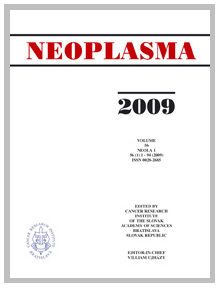Journal info
|
||
Select Journal
Journals
Bratislava Medical Journal Ekologia - Ecology Endocrine Regulations General Physiology and Biophysics Neoplasma 2025 Ahead of print 2024 2023 2022 2021 2020 2019 2018 2016 2017 2015 2014 2013 2012 2011 2010 2009 2008 2007 2006 2005 2004 2003 Acta Virologica Studia Psychologica Cardiology Letters Psychológia a patopsych. dieťaťa Kovove Materialy-Metallic Materials Slovenská hudba 2025Webshop Cart
Your Cart is currently empty.
Info: Your browser does not accept cookies. To put products into your cart and purchase them you need to enable cookies.
Neoplasma Vol.67, No.6, p.1456–1463, 2020 |
||
| Title: Significance of transcriptionally-active high-risk human papillomavirus in sinonasal squamous cell carcinoma: Case series and a meta-analysis | ||
| Author: M. ŠVAJDLER, J. NĚMCOVA, P. DUBINSKÝ, A. METELKOVA, P. ŠVAJDLER, Ľ. STRAKA, R. SAKAŘ, O. DAUM, M. MICHAL, A. SKÁLOVÁ, R. MEZENCEV | ||
| Abstract: Sinonasal cancers represent a highly heterogeneous group of head and neck cancers, for which etiological and prognostic significance of high-risk human papillomavirus (HPV) infections has not yet been conclusively established. We investigated the presence of transcriptionally-active high-risk HPV in a series of 34 sinonasal squamous cell cancer (SNSCC) cases and evaluated the effect of transcriptionally-active HPV on the overall survival. In addition, we performed a meta-analysis of previously published studies, including this study, to summarize the prevalence of HPV positivity across histological subtypes of SNSCC. The presence of transcriptionally-active HPV was detected by HPV mRNA using the polymerase chain reaction (PCR) or in situ hybridization (ISH). P16 expression was evaluated as a surrogate marker for transcriptionally-active HPV infection by immunohistochemistry (IHC), the presence of high-risk HPV DNA was tested by PCR and the HPV genotypes were determined by sequencing of PCR amplicons. Transcriptionally-active HPV infections were found in ~25% of the SNSCC cases. The role of HPV infection in keratinizing SNSCC may be higher than previously reported (~32% in our study vs ~0-6.3% in all other studies). Patients with transcriptionally-active HPV-positive SNSCCs were more likely to be diagnosed at earlier stages (p markers of transcriptionally-active HPV infections. However, p16/IHC may have significantly lower sensitivity as a surrogate marker of transcriptionally-active HPV in SNSCCs compared to OPSCCs. Furthermore, in our group of SNSCCs, all cases positive for high-risk HPV DNA by PCR were also transcriptionally-active (causative) infections with positive HPV mRNA by ISH. Our results imply a possible different role of HPV-mediated carcinogenesis of squamous cell epithelium in oropharyngeal and sinonasal sites with latter displaying a lower proportion of causative HPV infections; nevertheless, most cases positive for high-risk HPV DNA, p16/IHC or combination thereof were also found positive for transcriptionally-active HPV. Prognostic significance of HPV status in SNSCCs remains inconclusive and future studies should investigate the presence of transcriptionally-active HPV by direct HPV testing. |
||
| Keywords: sinonasal; squamous cell carcinoma; human papillomavirus; survival; p16 | ||
| Published online: 27-Aug-2020 | ||
| Year: 2020, Volume: 67, Issue: 6 | Page From: 1456, Page To: 1463 | |
| doi:10.4149/neo_2020_200330N332 |
||
|
|
 download file download file |
|

